A good-looking vegetarian dish with great flavour, spicy lotus root stir-fry can be made in just a few minutes. This recipe tells you all the essential facts about this special vegetable and how to pick the spicy seasoning sauce.
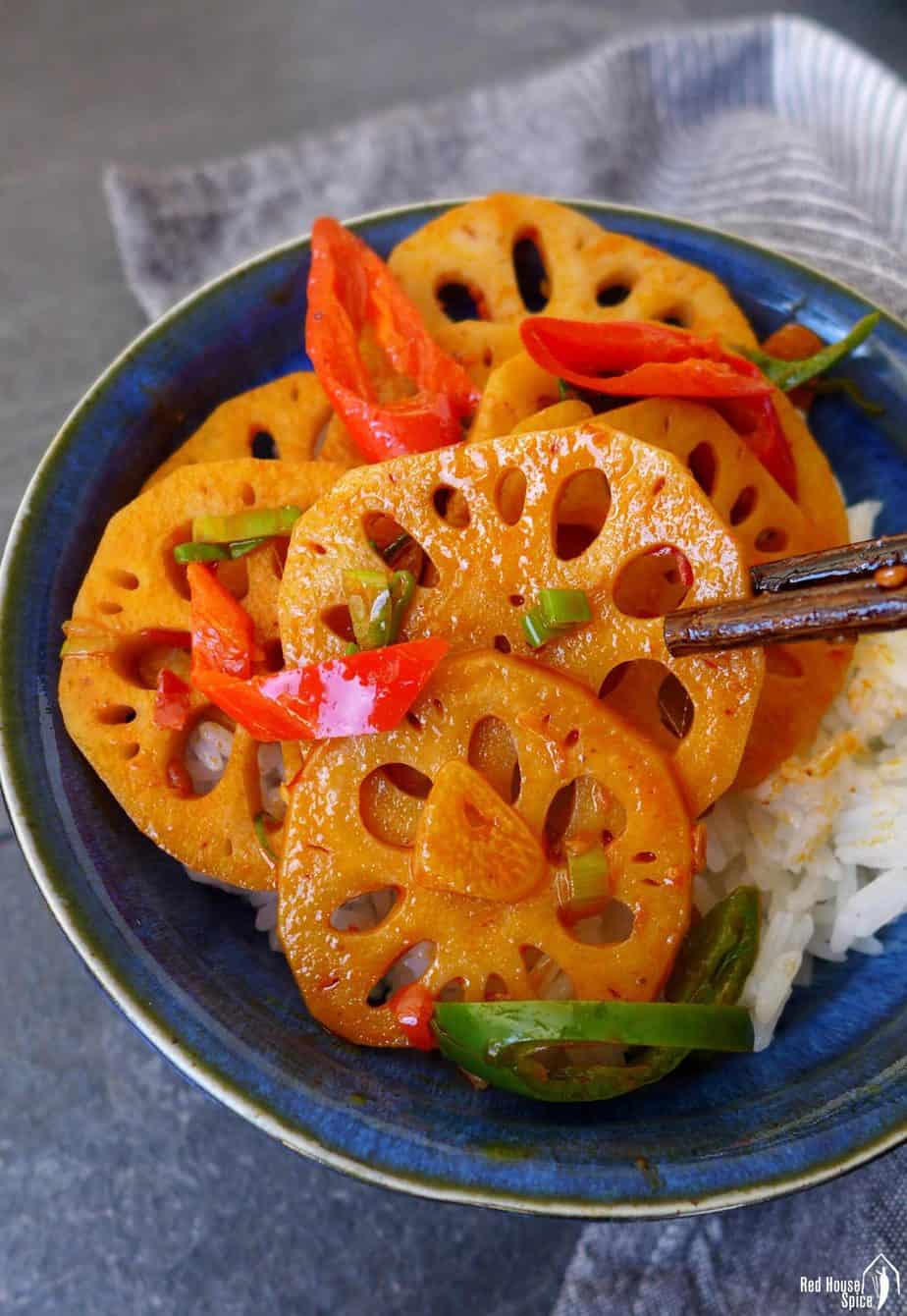
What is lotus root
Lotus root (Lian Ou, 莲藕) is a popular vegetarian ingredient widely used in Chinese cuisine. Although named as “root”, it is in fact the rhizome, a continuously growing horizontal underwater stem, of the lotus plant. It comes in connected, cylinder-shaped segments (like giant linked sausages). There are either seven or nine holes that run through the entire segment. When cut crosswise, you will see a “rotary dial phone” pattern which makes this ingredient extra interesting.
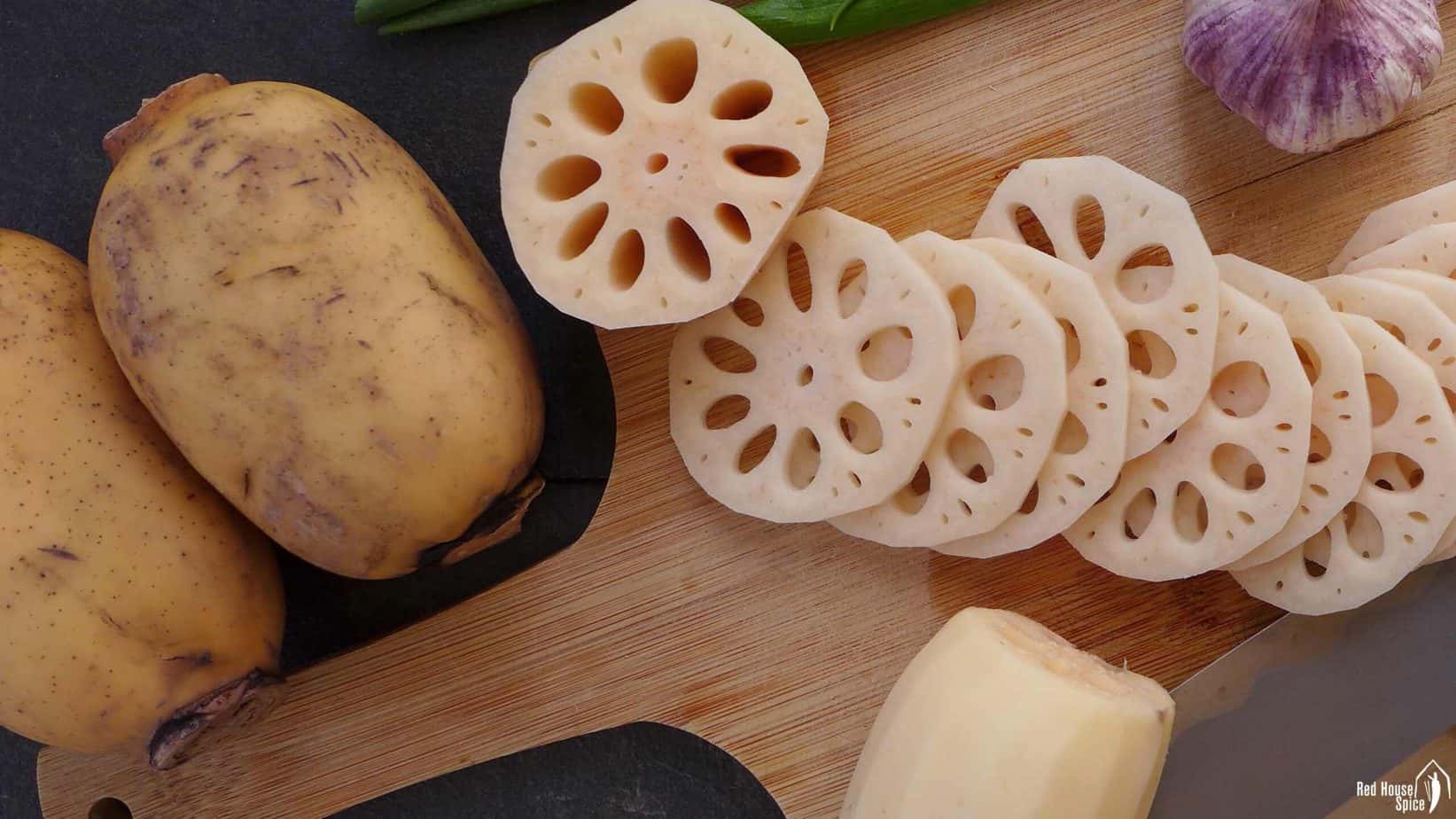
Having a slightly sweet and earthy taste, lotus root offers a crunchy texture when briefly blanched or stir-fried. If simmered in liquid for a lengthy period, it turns soft and tender, similar to the texture of boiled potato (eg. Sweet lotus root with sticky rice). Low in calories and high in fibre, lotus root can be cooked in many ways. Today’s spicy lotus stir-fry is about the easiest way to turn it into a delicious dish.
How to choose & store lotus root
You should be able to find lotus root in most Chinese stores. They are sold fresh or in vacuum plastic bags. When buying, I suggest you pick the fat & firm ones which don’t have much cracks or bruises.

The outer skin of lotus root tastes a little bitter thus need to be removed. A vegetable peeler does a good job. You should also discard the hard ends of each segment. I always like slicing it crosswise so the unique holey pattern can be seen. In some classic lotus root dishes, such as hot & sour lotus root (酸辣藕丁), you would find it diced into small cubes. Please feel free to do so if you prefer.
You can keep lotus root in the fridge for about two weeks (or follow the expire date if available). It freezes well too. Wash, peel and cut it into the desired shape. Store it in the freezer for up to three months. Defrost in the fridge before using.
How to stir fry lotus root
It’s not hard to cook a tasty stir-fry using lotus root as the star ingredient. As it goes well with almost all types of seasoning/sauce, you can improvise with inspiration from other classic dishes. For example, cook it in Sichuan garlic sauce or make it Kung Pao flavoured. My spicy lotus root stir-fry is one of the simplest among many choices.
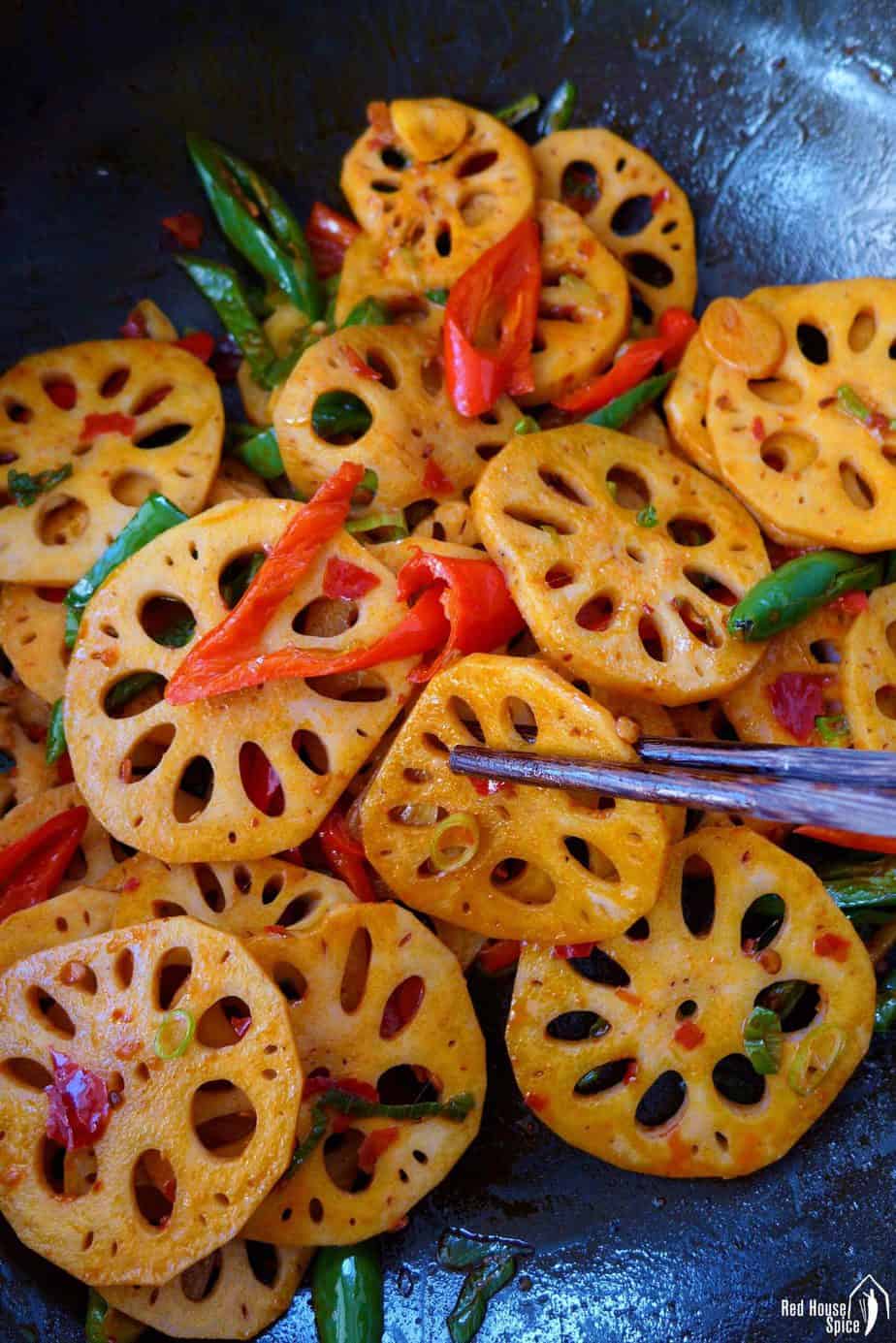
From start to finish, it takes less than 5 mins to cook the dish. Here is the procedure:
- Bring a pot of water to a boil. Blanch the lotus root slices for about 2 mins then drain well. In Chinese, this process is called Duan Sheng/断生 meaning “break the rawness”.
- Heat up oil in a wok over high heat. Add garlic & Sichuan chilli bean paste which provides the key flavour of the dish: spicy, aromatic and salty. Fry them until fragrant (Be careful not to burn).
- Stir in the lotus roots and sliced fresh chilli. Fry until all the pieces are evenly coated by the seasoning.
- Finally sprinkle finely chopped scallions. Give everything a quick stir then dish out.
How to choose Sichuan chilli bean paste
If you are into Sichuan cuisine (one of the most popular regional cuisines of China), I guess you already know the beauty of Sichuan chilli bean paste. Consisting of fermented broad beans and spicy chillies, it’s a fundamental condiment used to season many iconic dishes (eg. Mapo Tofu, Sichuan Boiled fish, etc.) As mentioned above, I use it to season my lotus root stir-fry.
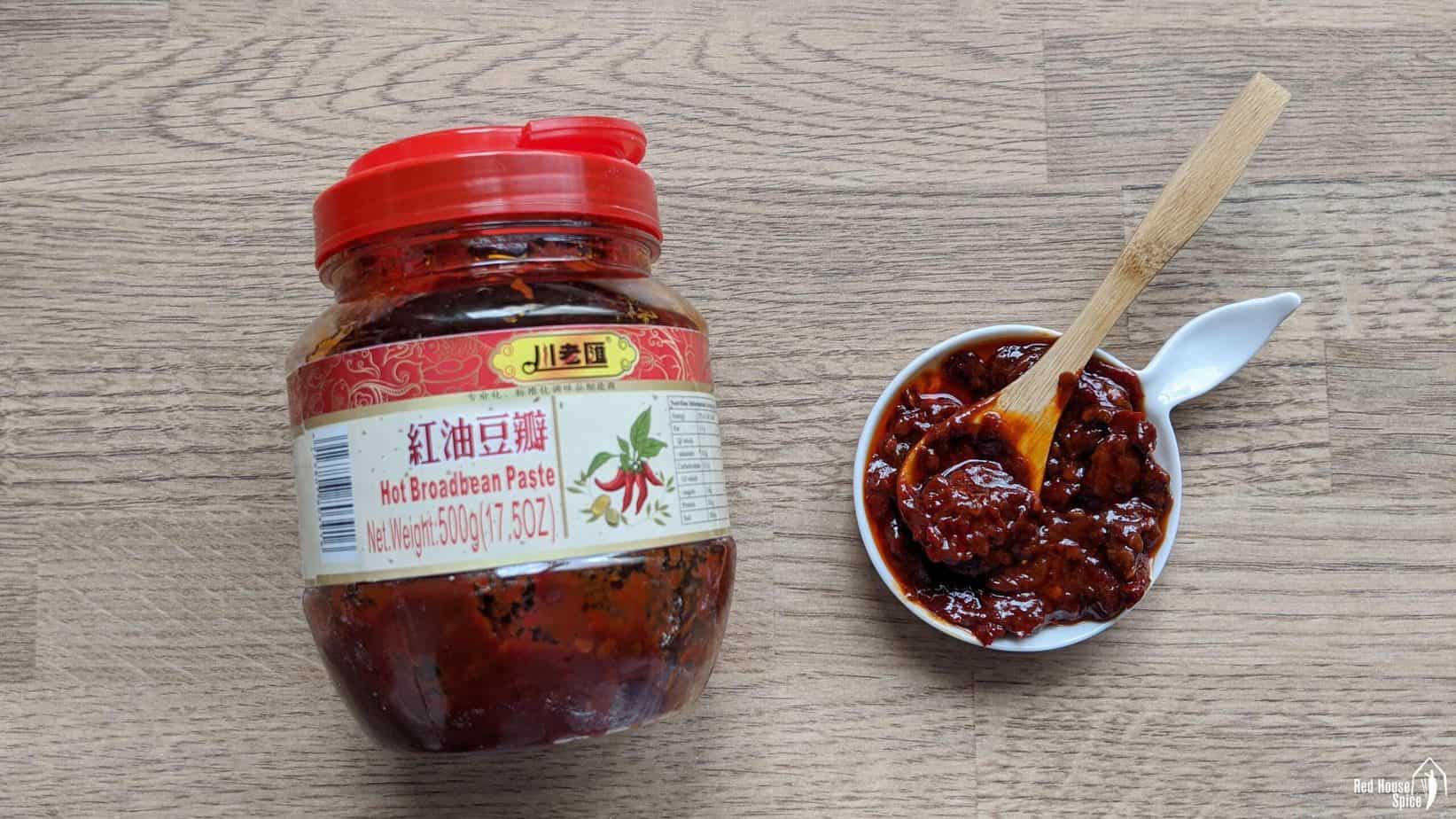
Sichuan chilli bean paste is widely available in Chinese stores/major online shopping platforms, but it can be very confusing when sourcing it. A variety of Chinese and English names used for this condiment often makes finding it a mission impossible. So I’d like to clarify a few terms to help you identify it.
- Dou Ban Jiang (Doubanjiang) is the Pinyin form for its Chinese name 豆瓣酱.
- Broad bean Paste is sometimes used as broad bean is the main ingredient.
- Pixian Dou Ban (or Pixian Broad Bean Paste/郫县豆瓣) is the best-known variety which is produced in a town named Pixian.
- Hot Broad Bean Paste (红油豆瓣) refers to the version with extra chilli oil. It’s a little spicier and has an appetizing red colour.
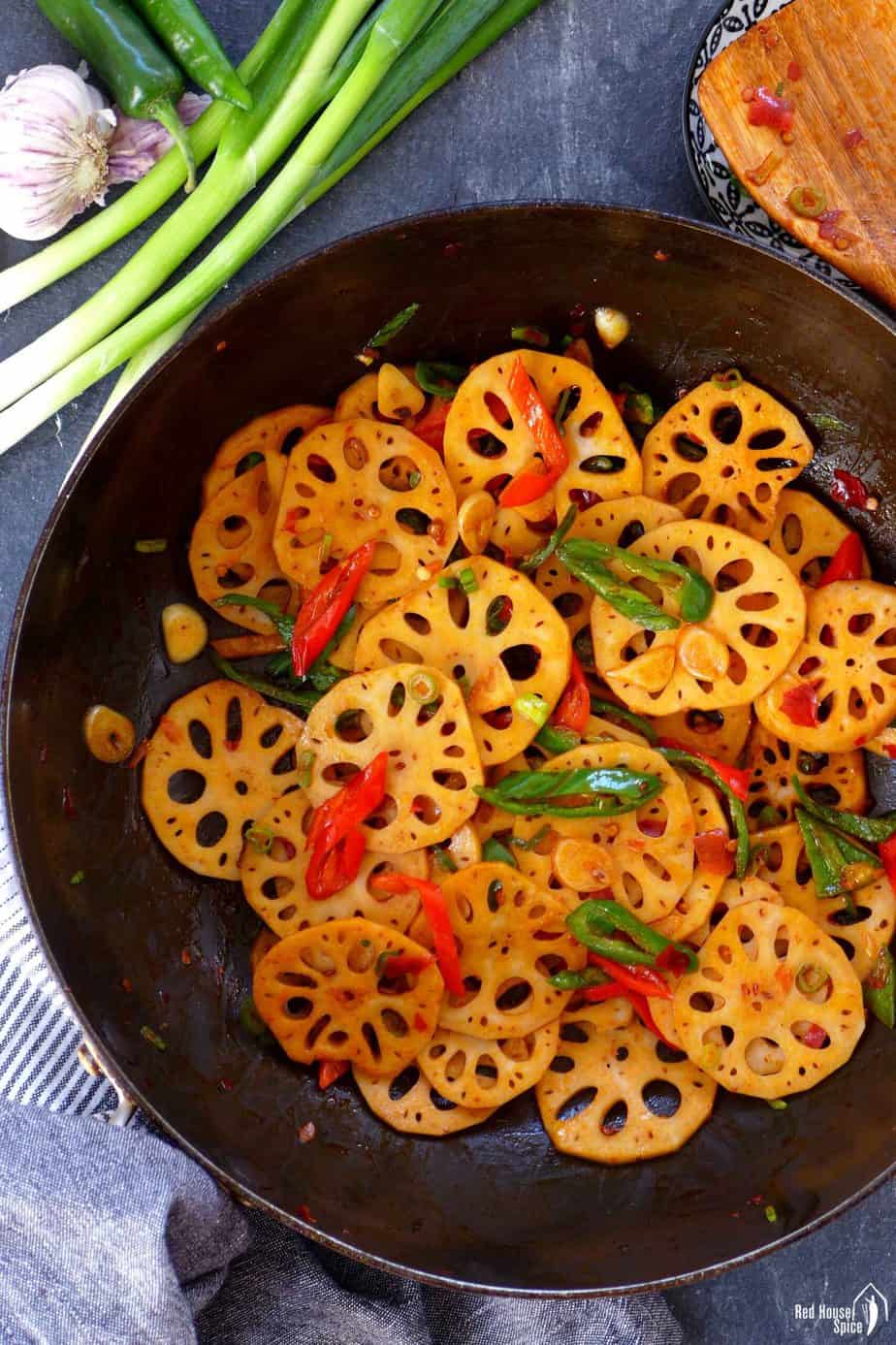
Other tasty stir-fry dishes on the blog
Check out the following recipes if you’re keen to broaden your Chinese stir-fry skills:

Spicy lotus root stir-fry (辣炒莲藕)
Ingredients
- 320 g lotus root - 11oz
- 1 tablespoon cooking oil
- 4 cloves garlic, sliced
- 1 tablespoon Sichuan chilli bean paste - see note
- 4 fresh chillies, sliced
- 1 pinch sugar
- 1 stalk scallions, finely chopped
Instructions
- Peel lotus root with a vegetable peeler. Discard the dark end bits. Then cut it into thin slices crosswise revealing its holey pattern.
- Bring a pot of water to a boil. Blanch the lotus root slices for about 2 mins. Drain well.
- Heat up oil in a wok. Add garlic & Sichuan chilli bean paste. Fry until fragrant.
- Put in the lotus roots and fresh chilli. Stir fry until all the pieces are evenly coated by the seasoning.
- Add scallions then give it a final stir. Dish out and serve immediately with plain rice.
NOTES
NUTRITION DISCLOSURE: Nutritional information on this website is provided as a courtesy to readers. It should be considered estimates. Please use your own brand nutritional values or your preferred nutrition calculator to double check against our estimates.




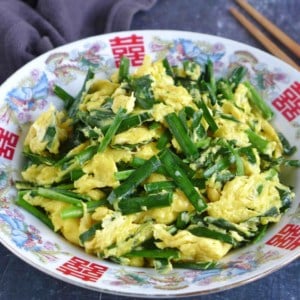

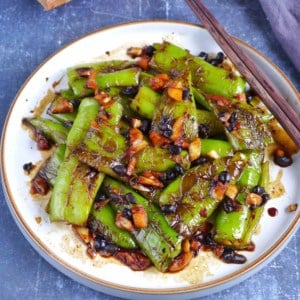

Hi Wei Guo,
This receipe looks pretty good and simple. I will be trying it tonight. Can you please add Sichuan chicken receipe.
Thanks
Hi Rakesh! I’m not sure which dish you mean by “Sichuan chicken”. Here are some classic Sichuan dishes using chicken: Kung Pao Chicken, Mala Chicken, Mouthwatering Chicken.
We lived in China for 3 years and Lotus root is one of my favorite additions/dishes. I cannot wait to make this version. What kind of chilis do you recommend in the dish? Serrano?
Welcome to my blog Anne! Please feel free to use any chili pepper available which is suitable for your tolerance to the heat. Happy cooking!
5 stars just for the section on which Sichuan chilli bean paste to use. This is helpful to people like me, who aren’t Chinese literate and don’t fully know what’s authentic, struggling to pick the right jar in an aisle with what seem like a million options. Doing my shopping in Flushing, Queens, I know at least one has to be the real deal! Thank you for pointing out that there out are similar things with different names.
My pleasure Nate! I know how frustrating it can be when it comes to sourcing unfamiliar ingredients. Glad that you find my post helpful!